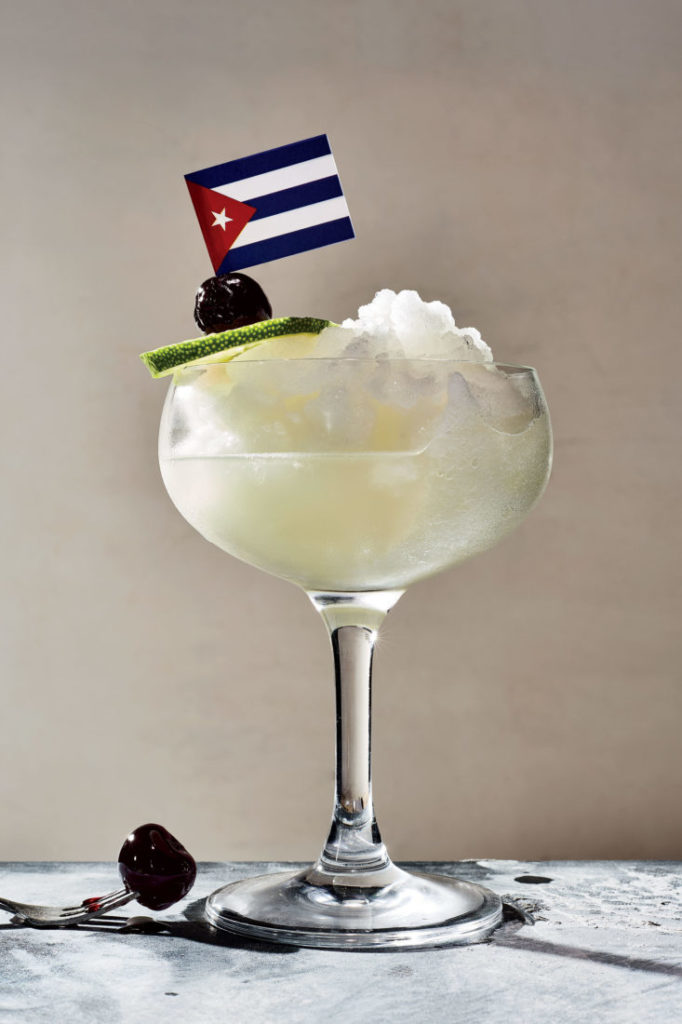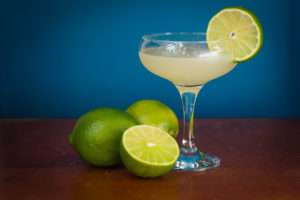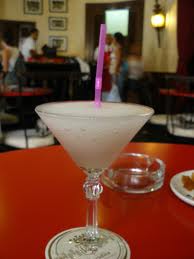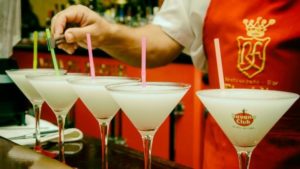 FAMOSAS BEBIDAS CUBANAS: EL DAIQUIRÍ. RECETA Y VERSIONES SOBRE SU ORIGEN. VIDEOS.
FAMOSAS BEBIDAS CUBANAS: EL DAIQUIRÍ. RECETA Y VERSIONES SOBRE SU ORIGEN. VIDEOS.
El nombre de Daiquiri es también el nombre de una playa cerca de Santiago de Cuba, y una mina de hierro en esa zona, y es una palabra de origen taíno. El cóctel fue inventado alrededor de 1900 en un bar llamado Venus en Santiago, a unos 23 millas (37 kilómetros) al este de la mina, por un grupo de ingenieros de minas de América. Entre los ingenieros estuvieron presentes Jennings Cox, General Manager of the Spanish American Iron Co., Francisco J. Linthicum, C. Manning Combs, George W. Pfeiffer, De Berneire Whitaker, C. Proctor Merritt Holmes y O. Persing. Aunque persisten las historias que Cox inventó la bebida cuando se le acabó la ginebra, mientras que entretener a los invitados de América, la bebida evolucionado de forma natural debido a la prevalencia de la lima y el azúcar.
El consumo de la bebida se mantuvo localizado hasta 1909, cuando el almirante Lucius W. Johnson, un oficial de Marina de los EE.UU. médica, trató la bebida de Cox. Johnson, posteriormente, introducido en el Ejército y la Marina del Club en Washington, DC, y los bebedores del daiquirí ha aumentado en el espacio de unas pocas décadas.
Algunas fuentes bien fundadas atribuyen al famoso cantinero Catalán Constantino Ribalaigua, “Constante” la creacion del Daiquiri, una original mezcla cubana. Y en distintas ocasiones bebedores y barmans de muchos países del mundo han visitado a la Habana a rendir homenaje a Ribalaigua, muerto hace ya muchos años en La Habana y que será recordado siempre por sus menciones en los escritos del famoso norteamericano Hemingway que no dejaba pasar una semana sin visitar el lugar y alabar la rica mezcla daiquiriana.
Originalmente la bebida se servía en un vaso alto lleno de hielo picado. Una cucharadita de azúcar se vertió sobre hielo y el jugo de la de uno o dos limones se exprimió sobre el azúcar. Dos o tres onzas de ron completado la mezcla. El vidrio esmerilado que entonces era removiendo con una cuchara de mango largo. Más tarde, el Daiquirí evolucionado para ser mezclado en una coctelera con los mismos ingredientes pero con hielo raspado. Después de una agitación a fondo, se vertió en un vaso flauta refrigerados. Un artículo del 14 de marzo 1937 edición de The Miami Herald, así como la correspondencia privada de JF Linthicum confirmar la receta y la historia temprana.
El daiquirí fue una de las bebidas favoritas del escritor Ernest Hemingway y el presidente John F. Kennedy.
Para mis lectores, les hago llegar la mejor receta de mi DAIQUIRI Cubano.
50 ml de ron cubano ligero
25 ml de jugo de limón fresco
Jarabe de azúcar 15 ml, o su equivalente en forma granulada.
Agitar con hielo, y luego colar en un vaso de cóctel. Adorne con una rodaja de limón, que ha sido cortado y luego se coloca en el borde del vaso.
La creación del Catalán Constantino Ribalaigua, “Constante” el llamado “Daiquiri Hemingway” en honor del famoso escritor norteamericano y con vista a la población turística que visita a la Isla para deleitar la agradable mezcla se hace asi:
2 oz ron blanco (al igual que DonQ Cristal)
.75 Oz jugo de lima
1 cucharadita de marrasquino
1 cucharadita de jugo de pomelo
1 cucharadita de azúcar
Agitar con hielo y verter en una copa de cóctel helada. Sirva frappe (hielo triturado apilado en el vidrio)
La receta básica para un Daiquirí es también similar a los marineros británicos bebían grog a bordo del barco a partir del 1740. En 1795 la Royal Navy ración diaria de ron ponche contenido, el agua, ¾ de onza de jugo de limón, y 2 onzas de azúcar. Esta era una bebida común en todo el Caribe, y tan pronto como el hielo llegó a estar disponible este se incluyó en lugar del agua. Historia de Jennings Cox es sin duda muy popular y tal vez fue el responsable de la denominación de la bebida, pero en cuanto a la creación de lo que estaba a unos 150 años de retraso.
La bebida se hizo popular en la década de 1940. En tiempo de guerra de racionamiento hecho whisky, vodka, etc, difícil de encontrar, sin embargo, debido a la política del buen vecino de Roosevelt (que abrió las relaciones comerciales y de viajes con América Latina, Cuba y el Caribe), el ron era fácil de obtener. La Política del Buen Vecino (también conocido como ‘El programa Panamericano “), ayudó a hacer de América Latina de moda. Las bebidas por lo tanto, a base de ron también se puso de moda, y el Daiquirí obtuvo un tremendo aumento en popularidad en los EE.UU que permanece inalterable hasta nuestros dias.
 FAMOUS CUBAN DRINKS: THE DAIQUIRÍ. RECIPE AND VERSIONS ON ITS ORIGIN. VIDEOS.
FAMOUS CUBAN DRINKS: THE DAIQUIRÍ. RECIPE AND VERSIONS ON ITS ORIGIN. VIDEOS.
The name of Daiquiri is also the name of a beach near Santiago de Cuba, and an iron mine in that area, and it is a word of Taino origin. The cocktail was invented around 1900 at a bar called Venus in Santiago, about 23 miles (37 kilometers) east of the mine, by a group of American mining engineers. Among the engineers were Jennings Cox, General Manager of the Spanish American Iron Co., Francisco J. Linthicum, C. Manning Combs, George W. Pfeiffer, De Berneire Whitaker, C. Proctor Merritt Holmes, and O. Persing. Although the stories persist that Cox invented the drink when the gin ran out, while entertaining the guests of America, the drink evolved naturally due to the prevalence of lime and sugar.
Drink consumption remained localized until 1909, when Admiral Lucius W. Johnson, a U.S. Marine officer. Doctor, he tried Cox’s drink. Johnson, subsequently, introduced to the Army and Navy Club in Washington, DC, and the drinkers of the Daiquiri has increased in the space of a few decades.
TRIBUTE TO CUBAN DRINK.
Some well-founded sources attribute to the famous bartender Catalan Constantino Ribalaigua, “Constant” the creation of the Daiquiri, an original Cuban mix. And on different occasions, drinkers and bartenders from many countries of the world have visited Havana to pay tribute to Ribalaigua, who died many years ago in Havana and who will always be remembered for his mentions in the writings of the famous American Hemingway who did not miss A week without visiting the place and praising the rich daiquirian mix.
Originally the drink was served in a tall glass full of crushed ice. A teaspoon of sugar was poured on ice and the juice of one or two lemons was squeezed on the sugar. Two or three ounces of rum completed the mixture. The frosted glass was then stirring with a long-handled spoon. Later, the Daiquiri evolved to be mixed in a shaker with the same ingredients but with shaved ice. After thorough stirring, it was poured into a chilled flute glass. An article from the March 14, 1937 edition of The Miami Herald, as well as the private correspondence of JF Linthicum confirming the recipe and the early history.
The daiquiri was one of the favorite drinks of writer Ernest Hemingway and President John F. Kennedy.
For my readers, I send you the best recipe for my Cuban DAIQUIRI.
50 ml light Cuban rum
25 ml of fresh lemon juice
15 ml sugar syrup, or it is equivalent in granulated form.
Shake with ice, and then strain into a cocktail glass. Garnish with a slice of lemon, which has been cut and then placed on the edge of the glass.
The creation of the Catalan Constantino Ribalaigua, “Constant” the so-called “Daiquiri Hemingway” in honor of the famous American writer and with a view to the tourist population that visits the Island to delight the pleasant mixture is done like this:
“Daiquiri Hemingway”
2 oz white rum (like DonQ Cristal)
.75 oz lime juice
1 teaspoon maraschino
1 teaspoon grapefruit juice
1 teaspoon of sugar
Shake with ice and pour into an iced cocktail glass. Serve frappe (crushed ice stacked in the glass)
The basic recipe for a Daiquiri is also similar to British sailors who drank grog on board the ship from 1740. In 1795 the Royal Navy daily ration of rum punch content, water, ¾ ounce of lemon juice, and 2 ounces of sugar. This was a common drink throughout the Caribbean, and as soon as ice became available it was included instead of water. Jennings Cox’s story is undoubtedly very popular and perhaps he was responsible for the denomination of the drink, but as for the creation of what was about 150 years late.
The drink became popular in the 1940s. In times of rationing war made whiskey, vodka, etc., difficult to find, however, due to the policy of the good neighbor of Roosevelt (which opened commercial and travel relations with Latin America, Cuba, and the Caribbean), the rum was easy to obtain. The Good Neighbor Policy (also known as ‘The Pan American Program’), helped make Latin America look fashionable.
Agencies/ Wiki / Internet Photos / YouTube / Arnoldo Varona/ www.TheCubanHistory.com
THE CUBAN HISTORY, HOLLYWOOD.









